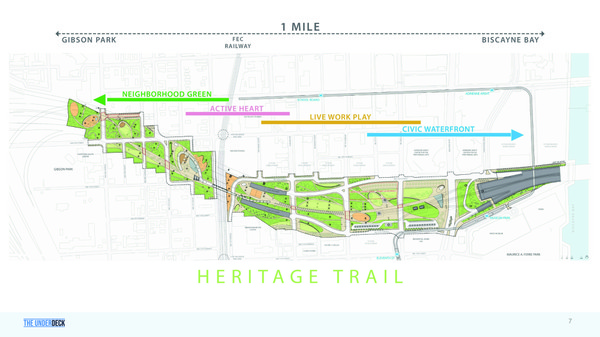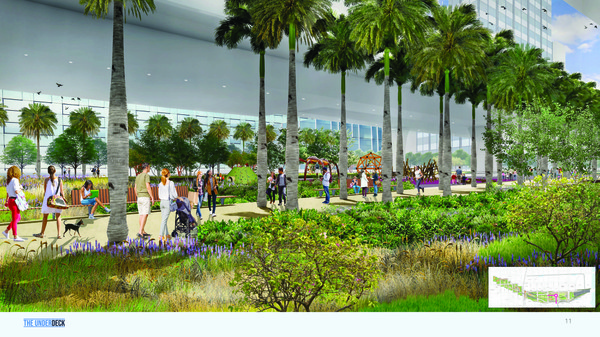Underdeck in planning stages while Underline gets big boost in funding
Miami-Dade County is currently in the process of changing the structure of its landscape with The Underline, a 120-acre linear park below the Metrorail that will ultimately extend from Brickell’s Miami River to the Dadeland South station in Kendall. Now, the state is planning to bring its own spine-like area of recreation to Miami, this time under a reconstructed I-395.
The Underdeck is an open-space project initiated by the Florida Department of Transportation (FDOT) that will serve as a key destination for residents and tourists alike while connecting Overtown to Biscayne Bay.

(Courtesy of Hargreaves Jones)
Presentation title here
The current design for the Underdeck shows a one-mile, 33-acre open space landscape beginning in Overtown and extending to Biscayne Bay.
The plan entered its early stages in 2017 when the state selected a proposal made by a joint venture between construction groups Archer Western and de Moya, which introduced plans for the space as part of their I-395/SR 836/I-95 Design-Build Project. The proposal most notably includes the construction of a signature bridge over NE Second Avenue and Biscayne Boulevard – now underway – that is expected to embellish Miami’s skyline in 2024.
Now, Nelson Adams, a member of what’s known as The Underdeck Committee, says progress is beginning to ramp up.
“It’s now our time to sow, to sow a seed into this green space that’s not just for us,” he said. “Hopefully we will be able to enjoy it, but it’s for our children and our children’s children and generations to come.”
FDOT reached out to the city of Miami and assigned it the responsibility of engaging residents and stakeholders, and in came The Underdeck Committee, officially called The Underdeck Subcommittee Advisory Group (USAG). The group is tasked with creating its own plan for the park – one that represents the vision of the local community.
The committee recently launched monthly community meetings to keep residents up to date and gather feedback. In March, one was held in Overtown and another at the Adrienne Arsht Center for the Performing Arts, both of which focused on the newly proposed design. Mary Lydecker of Hargreaves Jones, a consulting firm hired by the city to finalize the plans, was there, and has shared with the Biscayne Times what they’ve come up with.
Presentation title here
The Underdeck will feature open lawns, multiple interactive water features, and other amenities for residents and tourists.
The design consists of a single 33-acre landscape beginning near Overtown’s Gibson Park that extends across the Florida East Coast Railway tracks and reaches key cultural institutions near Biscayne Bay, including the Arsht.
The plan houses a variety of what’s being identified as character zones, including the “Civic Waterfront” near the bay where the signature bridge begins; a 24-hour active urban zone around the Omni district known as “Live, Work, Play” complete with a broad, open lawn and an interactive water feature; the “Active Heart” across the tracks that includes a dog park and a multi-use court; the “Neighborhood Green” zone, bringing event plazas, a “splash path” and a performance stage to Overtown; and the Heritage Trail, which will serve as a spine for the project connecting the east and west ends.
“This is a once-in-a-generation opportunity to restitch neighborhoods that were historically divided by the original construction of I-395 in the 1960s,” said Lydecker.
Still, members of the committee reminded those listening to the details of the plan that the USAG is first and foremost an advocacy group, encouraging residents to share their thoughts.
In turn, many spoke about possible health-related effects that may arise from frequenting a dwelling space that’s located under a major highway. Some were worried that the area and its public restrooms could be overrun by people experiencing homelessness. Others brought up safety, either for pedestrians crossing major intersections or for young people using the space during later hours.
What was also inevitably mentioned was the continued debate for The Underdeck’s official name, for which there has been much discussion between stakeholders and residents of Overtown wanting to reclaim the space that once destroyed their community. Virtual meetings have been held and a survey was conducted to gather feedback prior to making the final decision.

(Courtesy of Hargreaves Jones)
Presentation title here
The Heritage trail will connect the east and west ends of the Underdeck.
Additional concerns had to do with operations taking place behind the scenes, like where the money is going to come from.
The Underline was recently able to pick up $3 million in the 2022-2023 fiscal year’s state budget, which was approved by the Florida Legislature March 14, possibly serving as a sign that the state will be committed enough to the linear park trend so as to designate additional funds for The Underdeck as well.
But Lisa Martinez, the lead facilitator for the USAG, said that those answers are soon to come, assuring that finances will be the focus of April’s meetings. In the meantime, the plan is to assess the total cost of the committee’s proposed design compared to what was originally submitted to the state by the Archer Western-de Moya joint venture. If additional dollars are needed, the relevant working group will begin to explore available funding strategies.
The committee also wants to make sure that community involvement continues to be a priority for the state beyond these early planning stages. The USAG is committed to advocating for a plan of governance – one that gives residents a permanent seat at the table.
The city of Miami’s first deliverable is due to the state June 30. The Underdeck Committee plans to present its recommendations to the city manager by May 2, giving Miami ample time to review them and provide feedback before its commission meeting June 23.
To get involved, visit UnderdeckMiami.com.

